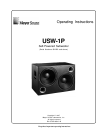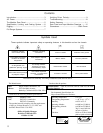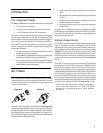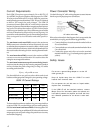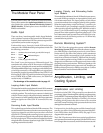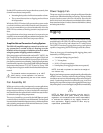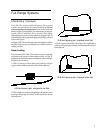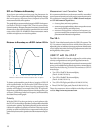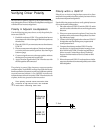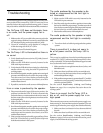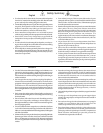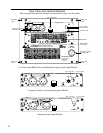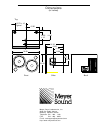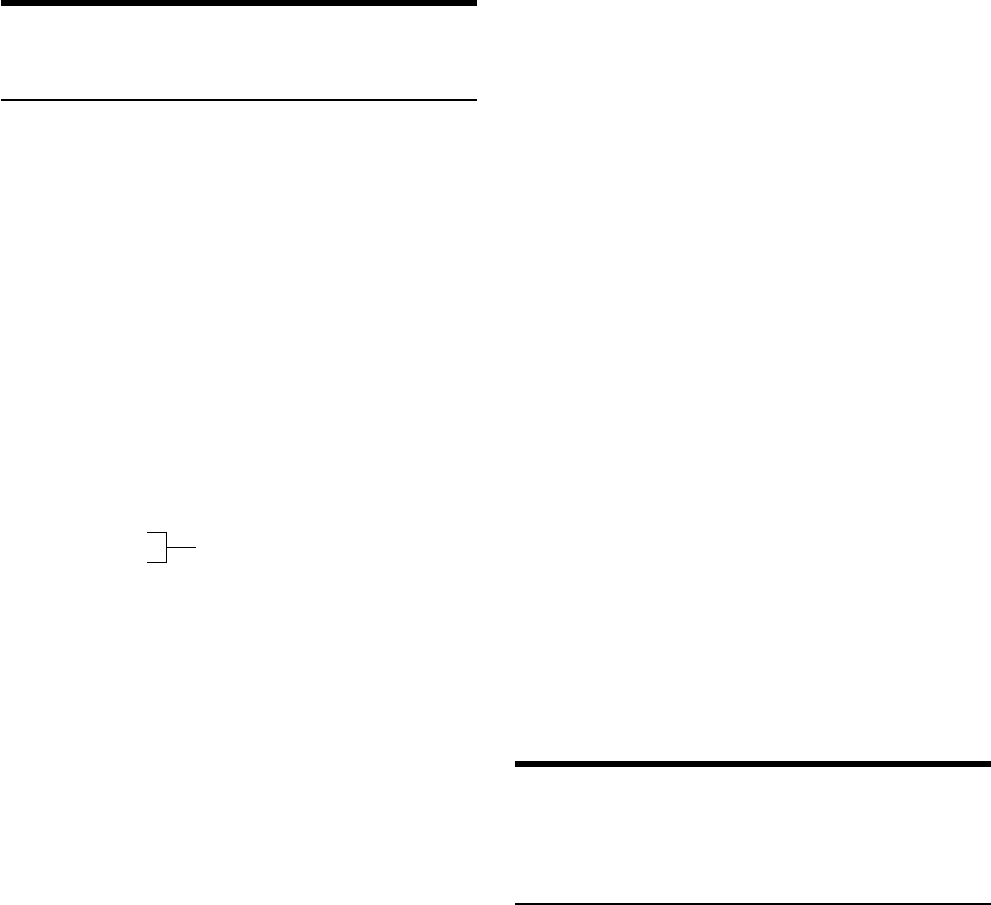
5
The Modular Rear Panel
The rear panel of the USW-1P has two slots for modules.
The top slot contains the Audio Input Module; the bottom
slot contains the optional Remote Monitoring System™
(RMS) Module. A blank plate covers the bottom slot if
RMS is not installed.
Audio Input
There are three, interchangeable Audio Input Modules
with optimized connectors and controls for different app-
lications. Each module has a 24V Fan connector to power an
optional fan (see fan section on page 6).
Each module uses a three-pin, female XLR audio input
connector with a 10 kΩ balanced input impedance wired with
the following convention:
Pin 1 — 220 kΩ to chassis and earth ground (ESD clamped)
Pin 2 — Signal+
Pin 3 — Signal-
Case — Earth (AC) ground and chassis
Pins 2 and 3 carry the input as a differential signal. Use
standard audio cables with XLR connectors for balanced
signal sources. A single audio source can drive multiple USW-
1Ps with a paralleled input loop, creating an unbuffered hard-
wired loop connection, with negligible loss in signal level.
For example, since the input impedance of one USW-1P is 10
kΩ, looping 20 USW-1P produces a balanced input imped-
ance of 500Ω. With a 150Ω audio source, the 500Ω load
results in only a 2.28 dB loss.
For drawings of the modules refer to page 12.
Looping Audio Input Module
This standard module uses a balanced, female XLR connector
for audio input and a male XLR loop connector to interconnect
multiple speakers. The audio input connector is hardwired
with pin 2 hot to comply with audio industry standards. The
loop connector, wired in parallel to the audio input, transmits
the input signal even if the USW-1P is turned off for any
reason.
Summing Audio Input Module
This module has two balanced female XLR connectors. The
second female XLR connector functions as a summing input.
Applying a signal to one of the inputs results in a normal
signal level. Utilizing both summing inputs creates a cor-
rectly summed mono signal with each input 6 dB below the
level of a single input. This is an effective method for distrib-
uting both sides of a stereo signal to a single USW-1P without
requiring external level control.
Looping, Polarity, and Attenuating Audio
Input Module
This module has a balanced, female XLR audio input connec-
tor, a male XLR loop connector, an input polarity switch, and
a level attenuator knob. The input polarity switch offers a
convenient method of reversing the polarity of the speaker.
When the input polarity switch is in the up (+) position, pin
2 is hot relative to pin 3, resulting in a positive pressure wave
when a positive signal is applied to pin 2. When the switch is
down (-), pin 3 is hot relative to pin 2, resulting in a positive
pressure wave when a positive signal is applied to pin 3. The
level attenuator knob operates between 0 dB (no level at-
tenuation) in a fully clockwise position to –12 dB in a fully
counterclockwise position.
Remote Monitoring System
The USW-1P can be equipped to operate with the Remote
Monitoring System (RMS) network and software applica-
tion. RMS displays signal and power levels, driver status.
limiter activity, the state of the polarity switch, attenuator
level, and amplifier temperature for all speakers in the
network on a Windows-based PC. RMS can also be config-
ured to enable speaker muting. RMS is an excellent field-
diagnostic tool that removes the guesswork from trouble-
shooting during a performance. All Meyer Speakers with
RMS can be integrated on the same network. Installing an
RMS module requires only a Phillips screwdriver. Contact
Meyer Sound for more information about RMS.
Amplification, Limiting, and
Cooling System
Amplification and Limiting
Each driver in the USW-1P is powered by one channel of a
proprietary Meyer Sound amplifier utilizing complementary
power MOSFET output stages (class AB, bridged). The USW-1P
employs two separate methods of limiting: Excursion
Limiting which protects the drivers from over excursion
and Sub Channel Limiting which prevents the drivers from
damage due to thermal overload.
Limiter activity for the Excursion and Sub channel is indi-
cated by two yellow Limit LEDs on the rear panel (the EXC.
Limit LED is above the SUB limit LED). See page 12 for a
diagram of the user panel.
The USW-1P performs within its acoustical specifications
and operates at a normal temperature if the limit LEDs are on
for no longer than two seconds, and off for at least one second.
Differential Inputs



